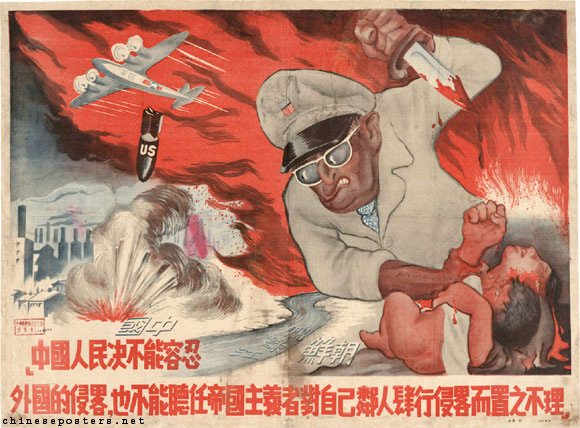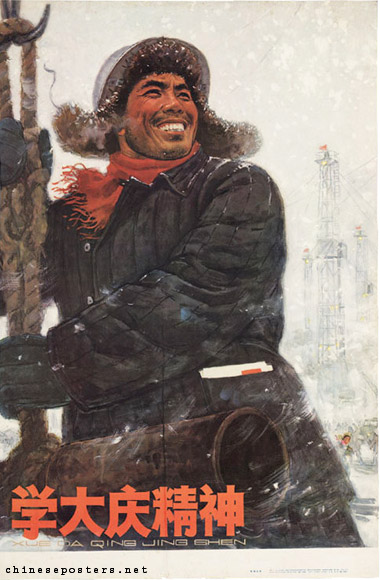Final Project Publication
“Red” In Propaganda
by Simon song
This project aims to explore and analyze the used art element, which is the color – Red, in propaganda posters. The analysis will be conducted from a combination of artistic and historical perspectives.
The object of this project is propaganda posters. A propaganda is a type of communication that aims to influence its audiences and further an agenda. Usually, they are created by governments, activist groups, religious organizations, etc. Due to that reason, propagandas are not objective most of the time. In order to send certain messages to the audience, they tend to exaggerate or manipulate facts so the audience will believe in preferred perspectives. In this project, we will explore a group of selected representative propaganda posters from China, and we will examine the use of red in them.
Red, as one of the most commonly used colors, people can see it in a great variety of art forms, from paintings to potteries. It can be used to paint fire, flower, and blood, and it can be used to represent something more abstract like victory, evil, and revolution. When it comes to history and politics, it is given new or untraditional meanings. A couple of centuries ago, the French put red on the flags to represent révolution. A bit more recent to modern days, the Soviet Union, Marxism, Socialism, and Communism all kept up the tradition of using red as a symbol of revolution. Even Imperial Japan, Nazi Germany, and The Red Right Hand (IRA) used red for different purposes. It is obvious that red has been politicized over the last few centuries. Understanding the transformation and application of red color through history is beneficial to a better understanding of art and history. And that’s one of the goals or significances of Art History, which is also what this project aims to achieve to a certain extent.
The selected ones were made at different times in China, and they all serve distinctive purposes while sharing some common characteristics. The reasons that they are chosen are the followings:
- Reflect the historical time period
- Featured meaningful element of “red”
- With authentic documentary and historical information
- Famous or impactful at the time they were made
These posters are arranged in chronological order to match with the history. There are five historical propaganda posters, and the themes or historical times they each individually represent are “Japanese Occupation (1937-1945)”, “Building the People’s Republic (1949-1956)”, “The Korean War (1950-1953)”, “Intervening years (1960-1965)”, and “Down with imperialism (1961-1966)”.
Disclaimers & Statements:
Due to propaganda’s political specialties and characteristics, viewers might find the descriptions and personal analysis objective or misleading to different extents. This project does not aim to promote, propagate, or dispute political views. Please view it with an open mind and understand that this project serves to provide historical information and various aspects.

https://chineseposters.net/gallery/e15-687
Designer unknown (佚名)
Ca. 1937
Swear to defend the nation to the death
Shiyu guotu gong cun wang (誓与国土共存亡)
Publisher: Junweihui zhengzhibu (軍委會政治部)
Size: 80×52 cm.
Call number: BG E15/687 (Landsberger collection)
This anti-Japanese propaganda is made by the Nationalist Party (Guomindang國民黨). The message of this poster is straightforward as it says “誓与国土共存亡”, which means “Swear to defend the nation to the death” at the bottom of the poster. This poster portrays a dedicated soldier standing tall on the wall with a rifle in his hand and looking into the distance. Another thing to notice is the soldier’s helmet. It resembles the iconic Stahlhelm used in the German Armies both in WWI and WWII. This doesn’t mean the soldier is from Germany; the German heritage of his equipment is because the Nationalist Party and German had decades-long friendship even before WWII. Therefore many Nationalist Party’s soldiers used German equipment.
The use of black and red on this poster makes the viewer feel the tension and seriousness of war with the words telling people to defend their homeland.
https://chineseposters.net/gallery/e15-687

https://chineseposters.net/gallery/d29-685
Designer: Su Guojing (苏国惊)
1950, December
Celebrating the People’s Republic of China’s National Day
Qingzhu Zhonghua Renmin Gongheguo Guoqingjie (庆祝中华人民共和国国庆节)
Size: 42×57 cm.
Call number: BG D29/685 (IISH collection)
This poster described a scene of people celebrating the national day of China, 1 October. At the front, people are wearing traditional customs and playing the traditional Ansaiyaogu(安塞腰鼓) drum. Behind them are the portraits of Chairman Mao Zedong and president Sun Zhongshan; the latter is the first president of the Republic of China. Both men are the first leader of China at different times and are highly respected. The children are wearing red scarves (红领巾), which is a comparatively new tradition. The red scarf symbolizes the national flag and the spirit of revolution, and students still wear them today.
The use of red on this poster definitely has a more cheerful meaning, different from wartime.
https://chineseposters.net/gallery/d29-685

Designer: Xu Ling (徐灵)
ca. 1950
The Chinese people absolutely cannot tolerate the invasion of other countries, and cannot allow Imperialists to wantonly invade its own neighbours without acting
Zhongguo renmin jue bu neng rongren waiguode qinlüe, ye bu neng ting ren diguo zhuyizhe dui ziji linren sixing qinlüe er zhizhi buli (中国人民决不能容忍外国的侵略,也不能听任帝国主义者对自己邻人肆行侵略而直之不理)
Publisher unknown
Size: 77×106 cm.
Call number: BG E27/169 (IISH collection)
The man in uniform is a caricature of Douglas MacArthur, a famous American general and the commander of the American troops in Korea.
This poster portrayed him as a vicious person committing war crimes holding a blood-soaked knife. It’s an apparent contrast comparing with posters made by Americans, and that shows how subjective propaganda can be.
The bright color red is used without reservation again; the blazing flame and blood have a strong visual effect on the audience.
https://chineseposters.net/gallery/e27-169

https://chineseposters.net/gallery/e13-950
Designer: Ha Qiongwen (哈琼文)
1965, June
Study the spirit of Daqing
Xue Daqing jingshen (学大庆精神)
Publisher: Shanghai renmin meishu chubanshe (上海人民美术出版社)
Size: 77×50.5 cm.
Call number: BG E13/950 (Landsberger collection)
Daqing is the name of an oilfield in the north-east of China. Workers conquered one obstacle after another and eventually exploited the oil. Thus, the Daqing oilfield became China’s national pride and an example of industrial development.
The snowy background and the black coat of the worker show contrast, and the red scarf, blushed face, and red text created another visual contrast. The use of red in this poster is to inspire the audience.
https://chineseposters.net/gallery/e13-950

Designer: Ha Qiongwen (哈琼文)
1965, July
American imperialism must be beaten!
Meidi bibai! (美帝必败!)
Publisher: Shanghai renmin meishu chubanshe (上海人民美术出版社)
Size: 107×77 cm.
Call number: BG G2/687 (IISH collection)
There are lots of debates around the Vietnam War. In China’s perspective, America’s interference in Vietnam’s own crisis and ambition to expand its foreign territory was an imperialism act. That’s no different from what Imperial Japan had done before. So when America supported the South, China supported the communist North to repel America’s invasion.
The woman in the poster is either Chinese or Vietnamese, and she’s wearing a scarf that’s similar to the iconic Chinese red scarf. The lower half of the poster portrayed the defeated American soldiers with the bold characters in red says “American imperialism must be beaten”.